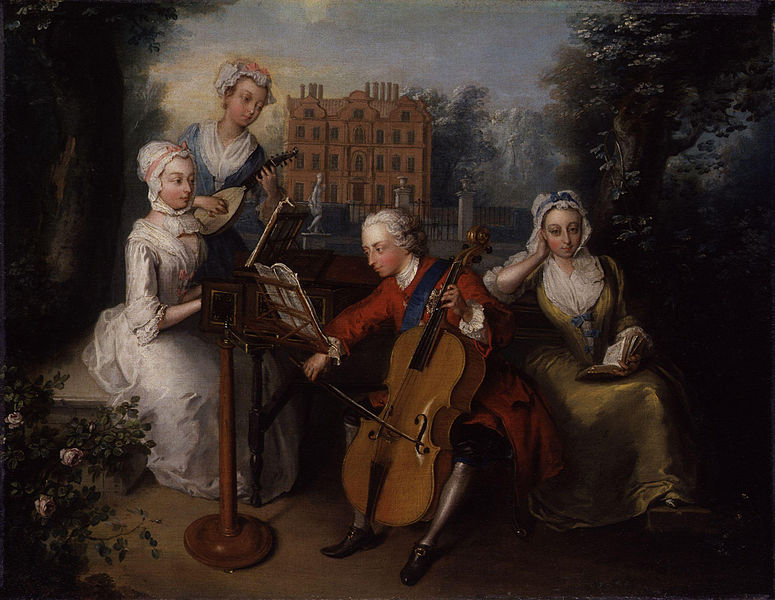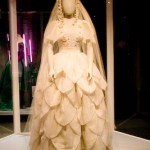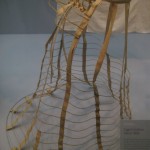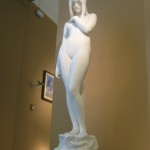I tried to make a list of the different representation that I saw in the National Portrait Gallery, but it pretty quickly devolved into the terrifying-pasty-rich-people-with-deformed-hands section and then insane-facial-expression-with-no-explanation section. I assumed coming in that the paintings in the older section would all be rich white people, so I wasn’t actually as upset about the lack of diversity as I normally would have been. (I actually read on the plaque next to Elizabeth that while paleness was in fashion for some of the period, other pale skinned depictions could be attributed to the fact that the red paint used to color cheeks fades over time. This doesn’t really explain why there are no other races represented, but it does explain why everyone looked like they were characters in a Tim Burton film).
Most of the paintings I took an interest in were monarchs, artists’ self-portraits, or famous historical figures. The modern section was a lot more exciting to me because I could actually tell some of the faces apart. I especially liked Maggi Hambling’s self-portrait (the woman with three arms) and the sculpture of Richard Rogers by Paolozzi (the head with bolts going through it and a deformed eye) because I think weirdness naturally lends itself to art. I tried to spend more time in the old-rich-white-people section, though, because I don’t think I’ve ever really given them enough credit. They all have the same hair and creepy elongated claw fingers, but their facial expressions, gestures, and other objects that appeared in the picture were a lot more telling than the austere impressive gentleman paintings that I usually see in textbooks I gravitated toward the paintings of the women, and it seemed like behind their organ cruncher outfits, they had a sense of humor that went over the heads of other people in the paintings. The portrait of Selina Hastings depicts her holding her temple like she has a giant migraine and pursing her lips in such a way that she might be contemplative, or she might be about to roll her eyes.
The painting I finally chose was another example of what I felt was an understated bond between exasperated women. Frederick Prince of Wales and his Sisters by Philip Mercier (1733) depicts Prince Frederick playing his cello accompanied by two sisters playing piano and mandora and the other reading Milton.
(from wikimedia.org)
Frederick is wearing red so the viewer’s eye goes to him immediately. He’s really engrossed in the music, leaning forward and wide-eyed. Anne and Caroline (the two sisters playing instruments) both look mellow enough, but upon closer inspection a little bored. Amelia (on the right) is my favorite. She’s the only one that looks right at the viewer, leaning her face in her hand like a 9th grader during a biology lecture and she looks completely exasperated. Frederick has no clue.
I know I’m romanticizing it a bit, but everyone either romanticizes art or deconstructs it until it’s ugly. So I’m going to romanticize it. The women in many of the paintings I saw, especially this one, are posed in such a way that no one can accuse them of anything, but they are mocking society. They look just serious enough that the eye rolling is overlooked by anyone that isn’t in on the joke. It’s a subtle art that seems to appear in groups with less power of being able to say something without ever saying anything. That’s why I wasn’t irritated that there was really no diversity represented in this time period. I think some of the subjects of the paintings know it (yes, I know I’m stretching it a lot, but these exasperated women really were all over gallery). Art enthusiast everywhere speculate about Mona Lisa’s secret chalking it up to a love affair or contemplation about the universe, but I think it’s the recognition that someone is full of it.
Tags: 2010 Jesse
September 10th, 2009 · 2 Comments
I had a huge problem with the Victoria and Albert Museum. Maybe that’s not the most gracious of ways to begin a post but it’s the only way that seems fitting. I was really excited to go to the museum. Not only had I heard only rave reviews from my classmates but I had also been introduced to just a taste of all the many ways that Victoria and Albert aided the arts and science communities on our very first day here on our tube stop adventure. I was expecting a museum that displayed some of the finest collections of art-sy and science-sy things shown off in an almost magical way. What did the museum show me though? Wedding dresses. The only thing I remember from all of the exhibitions is the fashion room. Maybe that wasn’t the best room for a person like me to go into (I’m not the best at coordinating colors and prints but, in my defense, I at least know that plaid and stripes don’t go together). Still, I think that a person without the least bit of fashion sense should be able to go into an exhibit in this type of museum and not come out with a feeling of outrage. Now, I have been researching feminist literary figures in the Bloomsbury area for the past week so maybe I’m a bit more sensitive to gender issues than I might normally be. That being said, the fashion room was laid out in a way that seemed to make the statement that the epitome of female dress could be found in a wedding dress. I don’t know if I’m alone in this sentiment but that statement couldn’t be more belittling or insulting. In my mind, glorifying a wedding dress in this way fits into the mindset that women are to only aspire to be a wife. I have nothing against marriage and think that being a stay-at-home-mom is quite a respectable position in life. But to be limited to such a role is wrong and it is exactly that limitation that I feel the fashion room in this museum was advertising.
Women have for years been actively pursuing equal opportunities in the workplace and home alike. Many women from the London area made great strides in assuring these opportunities came about. In the literary world, Virginia Woolf, George Eliot, Vera Brittain, Jane Austen– these are just a few of the women who pushed their way to the forefront of the literary world and showed that women had as much talent as men and should be given the opportunity to showcase that talent. Other influential women such as Millicent Garrett Fawcett, Sylvia Pankhurst, and Nancy Astor also have an important influence in the city. Let’s not forget that some of the most memorable sovereigns of the nation were women. Queen Elizabeth I, Queen Elizabeth II, and even Queen Victoria herself made contributions to the well being of the nation that cannot be overlooked. Though incredibly diverse in their many accomplishments, all of these women have one thing in common: their lives amounted to more than a wedding dress.
The Victoria and Albert Museum seems to ignore the rich history of powerful females in London though and, instead, caters to the idea that the aspiration of women is to look good on their wedding day. I think this is most clearly demonstrated in the wedding dress by Neymar that was worn by Angela Stamp on their wedding day in 1976. It was designed to resemble something Anne Boleyn would have worn.

Angela Stam's Neymar wedding dress
Anne Boleyn used marriage as a social stepladder more than possibly any other woman in history in my opinion. Taking any connection to the dress’s primary influence away though, the dress itself showcases exactly what the feminist movement was rebelling against in the 1970s. It is embroidered with beads and flowers and covered in frills and folds is such a way that it emphasizes the dress not the woman. In fact, the mannequin on display has absolutely no facial attributes at all. The woman is literally unnecessary. To me this implies that any woman can be placed into this dress, it wouldn’t matter at all who is in it. The dress is going to serve its purpose. The dress is going to find the desired husband (the husband who wants his wife in such a dress and will pay to make sure she looks like this to her public). Yes, it is crafted beautifully and is truly a sight to see. Other dresses were just as beautiful though, but it was this dress along with two other wedding dresses that were on display in single cases. It was this dress along with two other wedding dresses that attracted everyone’s attention. The museum is compiling a collection of wedding dresses for their wedding dress exhibit in 2013. It’s currently 2009. These wedding dresses aren’t a part of that exhibit. These wedding dresses are a part of the everyday collection and as such send the message (at least to me) that these are important enough to be set aside from all the other dresses because they are the most important clothes that women can ever put on. I would argue that’s just simply not the case.
I’m not even going to get started on the significant lack of male clothes present in the exhibit. There was a case of suits in the entire room. That was it. I recognize that that inequality is also a problem but the message of limitation through the wedding dresses was what struck me most in the room. Again, I was excited about seeing the museum. Victoria and Albert made incredible contributions to the art and science communities that shouldn’t be ignored. Unfortunately, the way in which the wedding dresses were displayed made all of their accomplishments completely invisible to me. All I could see was lace and embroidery.
Tags: Audrey · Museums
September 6th, 2009 · 1 Comment
No museum has affected me as viscerally as The Victoria and Albert Museum in South Kensington. Immediately upon entering the museum I was struck by the sight of life-sized Rodin sculptures of the human body that were raised above eye level, which created, for me, a sense of the insignificance of the appreciator, and likewise, the importance of art over all things. These sculptures were grotesque; Rodin used a technique that rendered them black and raw-looking, as if they had once been alive and thrown into a fire, then the charred remains removed and put on display. Though they were shocking and somewhat disturbing, Rodin’s pieces elicited in me a very emotional response, one that cut to the core of my perceptions of the self and of humanity, and one that I can neither explain nor recreate for the reader.
I also really enjoyed seeing several sculptures by Alfred Stevens, including a copy of the original “Truth and Falsehood” which is a part of The Wellington Memorial which we saw at St. Paul’s Cathedral several days ago.
The fashion and jewelry exhibits at the Victoria Albert were equally as touching, but for different reasons. Coming from a background in feminism, I was disappointed in those women who conformed to societal ideals of beauty – women who cinched their waists and bustled their butts, weighing themselves down with heavy jewelry, changing and shifting and molding themselves to ‘fit,’ quite literally, into the beauty myth. One display featuring a bustle and the wooden innards of a hoopskirt were reminiscent of a cage. And would it really be so far from the truth if it were?
Another exhibit which really hit me was photography. A great little exhibit, though I do wish it were larger. I thought that all of the works were quite good, though I connected on a deeper level with just two prints. The first piece was strikingly different. The artist worked with the principles of light and photography and used the sun to burn a simple design into the photo paper. I didn’t quite understand the process by which the piece was created but that’s the beauty of art, isn’t it? You don’t always have to understand it, or at least understand it as the artist does.
One piece that I definitely took a bit of “viewer’s license” to form my own interpretation was a photograph of a beautiful black model in a traditional Georgian dress and wig – both stark white. In her delicate hand she held a large diamond, perfectly cut and gleaming. Her head tilted towards the diamond in her hand, yet her eyes remained fixed intently on the camera. I thought that this piece, out of all the pieces of artwork I have seen at any exhibit thus far, had the most to say. It powerfully conveyed, by capturing just a single moment in time, hundreds of years of British imperialism and the pain it caused the imperialized. The Africans and West Indians were brought to perhaps not-so-‘Great’ Britain and taught that being ripped from their homelands like so many weeds was a privilege. They drowned the enslaved in western culture, which is represented by the model wearing the white (this was surely no mistake) Georgian garb, and meanwhile robbed their homelands of natural resources – such as diamonds and gold – for their own profit.
“Has imperialism, has slavery, really ended?” one must ask him or herself when one considers that there are still related issues in today’s society. The answer should become glaringly apparent when one considers Westerners’ continued thirst for diamonds. Though our presence in the diamond mines of Africa, in places like Sierra Leone, The Democratic Republic of Congo and Angola, may not be physical, our socially-sculpted ideologies surrounding the institution of marriage perpetuates these issues, and exacerbates the problems surrounding blood diamonds. So, for all you ladies out there: next time you stare doe-eyed into a Zales’ display window and exclaim in “I can’t wait to get married!” think twice about what societal forces and social constructions may be at work when you consider the “necessity” of an engagement ring. And the next time you look at a piece of art, everyone, look a little deeper and listen a little closer to what the piece may be trying to say.






Tags: Anya · Museums
September 1st, 2009 · 9 Comments
Since I’ve studied Italian for five years, hearing that we had to attend an Afro-Caribbean version of Carnevale caused me to instantly form a few preconceptions. I mistakenly thought that they would be similar; the parade’s commencement immediately smashed this idea. I’ve never seen a gathering so crowded and openly risqué. The sheer number of people was staggering to me, as were the number of food options. I could barely keep up with all that I saw as I was walking, and I enjoyed taking in the smells, sounds, and culture in general.
One thing that irked me, however, was the role of the women in the parade. Scantily clad and dancing in high heels, they wore a full face of makeup and clearly had put a lot of effort into their appearance. They all strutted down the street confidently and didn’t mind posing for pictures. I can’t decide whether I think they were liberated or confined by their role in the parade.
On the one hand, these women line up almost exactly to societal standards of sexuality. Their unnatural appearances reminded me of magazine ads: airbrushed, changed, and deliberate. They literally covered only the barest necessities of their bodies, and there is no doubt in my mind that they were sexualized, both by the parade in general and the infinite number of gazes upon them. Everything from the way that they looked to the way that they moved exuded sensuality.
However, they were entirely unbothered by it. Perhaps their ability to flaunt their bodies in such a way was actually a form of liberation. Some of the women were far from the stick-thin models we are pressured to look like, yet they still flaunted their assets, no pun intended. The fact that they were able to put society’s standards for women (which are normally at least somewhat hidden) completely on display was very interesting. None of them showed the slightest glimpse of shame or regret for their actions, and their confidence was almost inspiring.
I think their role in the parade can be seen as a release, but I’m curious to hear what others thought.

Tags: Amy









